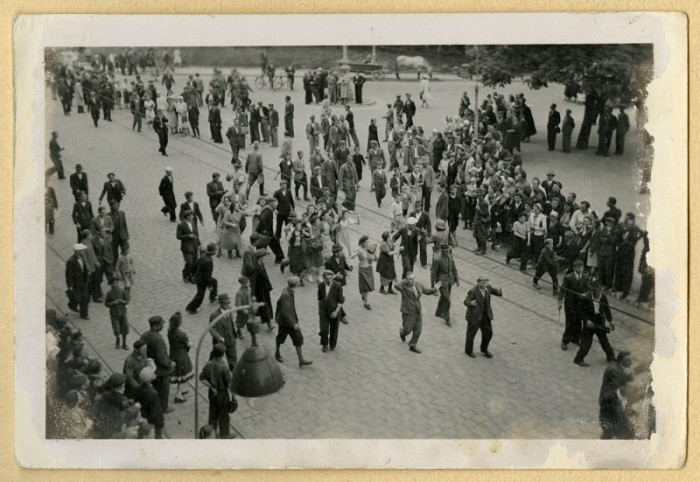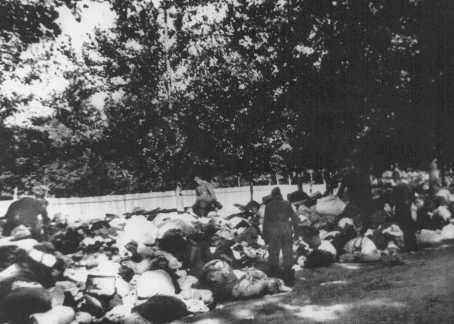
Bystanders
Dictionaries define “bystander” as “a witness to events,” “one who is present but not taking part in what is occurring.”
Key Facts
-
1
“Bystanders” is a catch-all term that has often been applied to people who were passive and indifferent to the escalating persecution that culminated in the Holocaust.
-
2
After the war, many ordinary Germans and Europeans claimed that they were “not involved,” that they were “bystanders” to the events of the Holocaust. Use of the term “bystander” to avoid any responsibility for what happened, however, obscures the many different levels of individual involvement at all levels of society.
-
3
Reviewing the use of “bystander” as a general category leads to a more nuanced exploration of the full range of behaviors and what people did—or did not do—to facilitate the persecution and mass murder of other human beings.
Background
Unlike present-day crime scenes, accidents, or emergency situations witnessed by “bystanders,” much was different about the Holocaust. Leaders of Nazi Germany driven by ideological goals formed the policies. Civil servants, police, and military forces—servants of the state—and their collaborators in other countries implemented the escalating racial measures, including anti-Jewish measures, which culminated in mass murder and genocide.
The Holocaust was a series of events that happened over a long period of time. Jews were dehumanized, deprived of many legal rights, became the victims of both random and organized violence, and were socially if not physically isolated from the rest of the population. Many people became “bystanders” to this ever-radicalizing program long before the mass roundups and killings began.
Who Were the “Bystanders”?

The term “bystander” is used in the context of the Holocaust in two ways. The first refers to external or international “bystanders”—witnesses in a nonliteral sense because of their distance from the actual events. These “bystanders” range widely from the Allied governments and neutral countries to religious institutions and Jewish organizations. The second—the focus in this article—refers to “bystanders” within societies close to and often physically present at the events.
“Bystanders” as used to refer to German and European populations close to the actual events are often defined by what they were not. They were not the “perpetrators” or the “victims.” Nor were they among the tiny minority of “rescuers” of the “victims.” “Bystanders” as a group have often been characterized as “passive” or “indifferent.” They included those, for example, who did not speak out when they witnessed the persecution of individuals targeted simply because they were Jewish, or during the phase of mass murder, did not offer shelter to Jews seeking hiding places.
The two words “passive” and “indifferent” themselves have distinct connotations. “Passive” implies “inaction.” Passivity could derive from a range of quite different feelings: from a sense of powerlessness, fear for one's physical safety, social pressures within one's group or community, or tolerance or support for the perpetrators' actions.
“Indifferent” is defined as “having a lack of interest in or concern about something: apathetic.” The “indifference” of “bystanders” to the plight of Jews is often attributed to people's daily preoccupations, from surmounting the hardships of the economic depression of the 1930s to focusing on the survival of their families in the face of wartime deprivations and suffering.
Existing antisemitic prejudices, including traditional religious forms of antisemitism, heightened by Nazi propaganda efforts to divide peoples of different ethnic backgrounds, resulted in many people seeing Jews as “alien,” contributing to the climate of passivity or apathy.
But what about “bystanders” who were not “passive,” “indifferent,” or “apathetic”? Many people became involved to various degrees over time in events of the Holocaust than is usually implied by the catch-all “bystander” tag and the characterizations associated with it.
Levels of Involvement
After the war many ordinary Germans and Europeans claimed that they were “not involved”—in essence, that they were “bystanders.” Refusal to take any responsibility for what happened, however, obscures the reality of the involvement of people at all levels of German society and beyond. Many onlookers to events who approved or tolerated what they witnessed were also involved.
Within Nazi Germany many individuals became active or semi-active participants in Nazi racial and antisemitic policies. These included civil servants who became involved as part of their normal work: finance officials processing tax forms, including the steep “tax on Jewish wealth” imposed after Kristallnacht or processing property seized by the state, including homes and belongings left behind following the “resettlement” of Jews during the war into occupied territories; clerks who kept files of identification documents that included one's “race” or “religion”; school teachers who followed curricula incorporating racist and antisemitic content.
Individual citizens chose to be involved when, out of a sense of duty, or prejudice, or some opportunity for business or other personal gain, they voluntarily denounced their co-workers and neighbors to the police.
Teenagers in many communities became involved when they enjoyed their newfound power to harass with impunity Jewish classmates or even adults to whom youth were generally taught to defer—thereby contributing to the isolation of Jews.
Many ordinary Germans became involved when they acquired Jewish businesses, homes, or belongings sold at bargain prices or benefited from reduced business competition as Jews were driven from the economy. With such gains, these “bystanders” developed a stake in the ongoing persecution of the dispossessed.
Outside Nazi Germany, countless non-Germans, from leaders, public officials, and police to ordinary citizens became involved by collaborating with the Nazi regime following the German occupation of their countries during World War II. Individuals helped in their roles as clerks and confiscators of property; as railway and other transportation employees; as managers or participants in roundups and deportations; as informants; sometimes as perpetrators of violence against Jews on their own initiative; and sometimes as hands-on killers in killing operations, notably in the mass shootings of Jews and others in occupied Soviet territories in which thousands of eastern Europeans participated.
In communities across Europe where the Germans implemented the “Final Solution to the Jewish Question,” they needed the help of people with local languages and knowledge to assist them in finding Jews who evaded roundups. As German and local police found willing helpers lured by the opportunity for material gain or rewards, Jews in hiding in countries from the occupied Netherlands to occupied Poland faced daunting odds of survival.
A Range of Helping Acts

The number of “rescuers” who either actively worked to save Jews, often as part of resistance networks, or who responded to requests to shelter them, was relatively small. This form of help, if discovered, especially in Nazi Germany and occupied eastern Europe was punished by arrest and often execution.
A larger group of witnesses to the victims' suffering assisted in lesser ways. A small minority publicly expressed their solidarity with the persecuted—notably mostly isolated clergymen in some communities in Nazi Germany and occupied countries. Other individuals assisted the victims by purchasing food or other supplies for Jewish households to whom shops became closed; by providing false identity papers or warnings about upcoming roundups; by storing belongings for those on the run that could be sold off little by little for food.
In small acts of kindness, some individuals publicly embraced Jewish friends and neighbors when they were being taken from their homes to trains for “resettlement” or pressed sandwiches or blankets into their hands. Jewish survivors often vividly remembered these moments because of their humane and exceptional character.
Beyond the “Bystander” Category?
The examples above help us break apart the “bystanders,” a large group encompassing vast populations often regarded as all alike. They show the possibilities for acting in ways more—or less—beneficial to the victims. Drawing on the evidence of such examples, particularly of the high levels of active or semi-active involvement in events of the Holocaust, a growing number of scholars in recent years have argued that the term “bystander” is becoming obsolete and should be jettisoned because of its connotations of passivity and inaction.
More research on the social dynamics within affected groups and communities across different regions and countries is needed. Additional future studies will help us to portray more fully and in all shades of gray, the range of behaviors that marked relations between Jews and non-Jews—to continue to move beyond broad generalities about “bystanders.”
Future research should also provide a better understanding of how in different places and times, people were mobilized or came to do what they did—or did not do—to facilitate the persecution and mass murder of other human beings.
Critical Thinking Questions
- How do bystanders, or witnesses, contribute to the possibility of mass atrocity?
- How can indifference to, insensitivity to, or tolerance of hurtful acts be combated?
- How do meanings of words change over time? What connotations do the words “bystander” and “witness” have? Are they the same?

